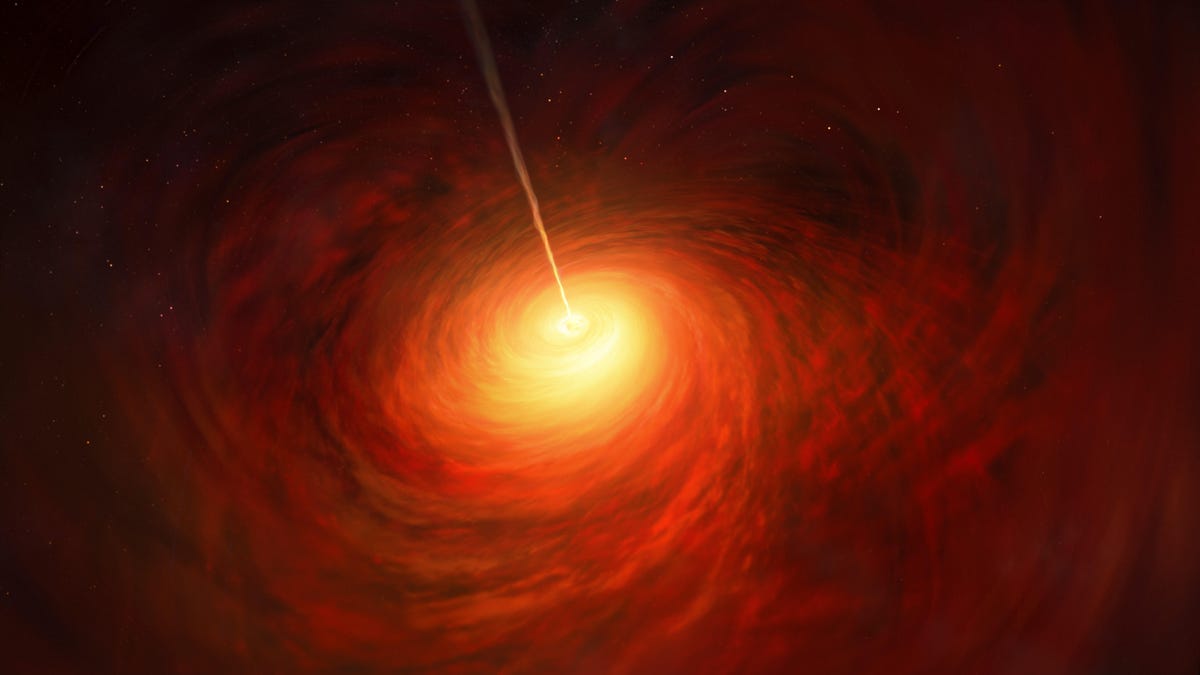First black hole image gets an upgrade, revealing extreme magnetic fields
Using polarized light, researchers with the Event Horizon Telescope collaboration reveal the environment close to the famous, mammoth black hole.

An artist's impression of the extreme environment at the center of galaxy Messier 87. A huge cosmic jet streams out of the central black hole.
When the Event Horizon Telescope captured the very first image of a black hole at the center of the Messier 87 galaxy around 53 million light-years from Earth, astronomers and scientists were delighted. The breakthrough snap had unlocked a powerful new way to study the behemoth cosmic beasts and put some of the most interesting astrophysics theories to the test.
The supermassive black hole at the center of Messer 87, dubbed M87*, has slowly been giving up its secrets as astrophysicists have combed through the huge amount of data generated by the EHT. On Wednesday, a few more secrets were unearthed as members of the EHT Collaboration reveal new images of the black hole in polarized light.
In a suite of new papers, the collaboration details new breakthrough images, which provide critical information about the magnetic fields immediately surrounding the black hole and those further from Messier 87's chaotic center. It's the first time a team has been able to measure polarization right up close to the edge of a black hole.
"The newly published polarized images are key to understanding how the magnetic field allows the black hole to 'eat' matter and launch powerful jets," said Andrew Chael, an astrophysicist at the Princeton University Center for Theoretical Science and member of the EHT Collaboration.
But what exactly is polarization, and why does it matter?
Well, light is weird. It's made up of electric and magnetic fields, vibrating in all sorts of directions. Polarized light is only vibrating in one direction. Most light is non-polarized when it leaves a star or the huge, bright disc of gas and debris around a black hole, but its interactions with dust, plasma and magnetic fields can cause it to polarize. Detecting polarization then provides a signature of the environment around a black hole like M87*.
The first black hole image provided a kind of blurry Eye of Sauron, a ring of orange and yellow light around a black spot. The light emanates from a disc of debris and material immediately surrounding the invisible black hole. Some of this matter slips into the black hole, never to be seen again, but other material is blasted out at right angles, deep into space in what is known as a "cosmic jet."
M87's jet of matter is ejected at nearly the speed of light and extends almost 5,000 light-years into space. But how it forms remains a mystery.
The first image of the black hole (left) and the new image, in polarized light (right).
The new observations provide a potential explanation.
"The observations suggest that the magnetic fields at the black hole's edge are strong enough to push back on the hot gas and help it resist gravity's pull," according to Jason Dexter, an astrophysicist at the University of Colorado Boulder and coordinator of the EHT Theory Working group. "Only the gas that slips through the field can spiral inwards to the event horizon."
The magnetic fields closest to the black hole may be so extreme that they're blasting matter away from the edge and focusing it into the huge jet observed emanating from Messier 87.
This is the jet emanating from the center of Messier 87. The yellow lines in the image indicate the magnetic fields present in the jet, which extends around 6,000 light-years into space.
The Event Horizon Telescope is not a single telescope, but a series of eight Earth-based telescopes located across the globe. It's a "virtual telescope," as big as the Earth, that captures the light escaping from around M87*, providing the kind of resolution required to resolve these features, even though it lies millions of light-years away.
One particular telescope that forms part of the collaboration, the Atacama Large Millimeter/submillimeter Array (ALMA) in Chile, also provided a stunning look at the black hole's jet in polarized light, displaying the magnetic field lines (right).
It also observed Sgr A*, the black hole at the center of the Milky Way, and a dozen other supermassive black holes, finding that extremely bright beasts with jets pointing directly at the Earth (known as "blazars") were very strongly polarized, which the researchers hypothesize is likely because of the direction they face.
The first image of a black hole wowed, but there are plenty more mysteries to be uncovered. The EHT will provide further opportunities to study the regions closest to M87* and Sgr A* as more observatories are added and the network is upgraded.
"We expect future EHT observations to reveal more accurately the magnetic field structure around the black hole and to tell us more about the physics of the hot gas in this region," said Jongho Park, an astrophysicist at Taipei's Academia Sinica Institute of Astronomy and Astrophysics and member of the EHT collaboration.

